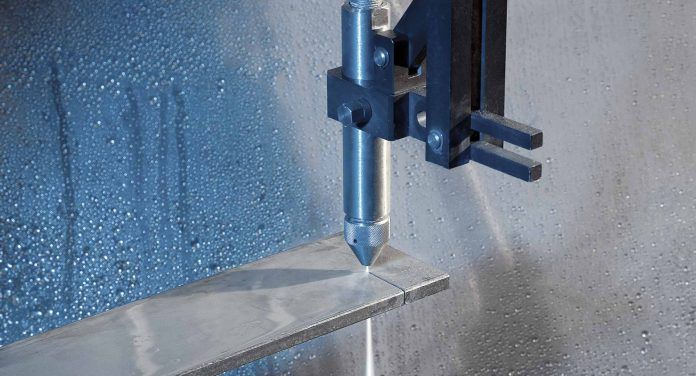Water Jet Cutter
A water jet cutter also called a water jet cutter, is an industrial tool capable of cutting a wide & think the variety of materials using extremely high-pressure water, abrasive materials. or a mixture of water The term abrasive jet refers to the use of water and abrasive alloys, especially for cutting hard materials such as metal, stone, or glass, while the term pure water jet and water only cutting refers to water jet cutting. Without the use of any additional abrasives. Used for soft materials such as wood or rubber.
Water jet cutting is often used in the manufacture of machine parts. This is the preferred method when the material being cut is sensitive to the high temperatures generated by other methods; Examples of such materials include plastic and aluminum. Water jet cutting is used in a variety of industries, including mining and aerospace, for cutting, shaping, and rebuilding.
Although high-pressure water was used for cutting with hydraulic mining until the mid-1800s, it was not until the 1930s that narrow water jets began to appear as an industrial cutting tool. In 1933, the Paper Patents Company in Wisconsin developed a paper measuring, cutting, and railing machine that used a water jet nozzle with a slanting motion to cut horizontally moving sheets of paper continuously. ۔ These early applications were low pressure and limited to soft materials such as paper.
Price
Check the price of water jet cutter: Here
Benefits
A major advantage of water jets is their ability to cut material without interfering with their hereditary structure, as there is no heat-affected zone (HAZ). By reducing the effects of heat, metals can be cut without overheating, without irritating, or without altering the internal properties. Sharp corners, bevels, drilling holes, and minimal internal radial shapes are all possible.
Water jet cutters are also capable of producing complex cuts in materials. With specialized software and 3-D machining heads, complex shapes can be created.
The curve, or width, of the cut, can be adjusted by changing the parts in the nozzle, as well as by changing the type and size of the abrasive. Non-abrasive cuts are typically 0.007 to 0.013 inches (0.18–0.33 mm), but they can be as small as 0.003 inches (0.076 mm), roughly the size of human hair. These small jets can allow small details in a big range
Due to its relatively tight curve, water jet cutting can reduce the amount of scrap material produced by allowing non-cut parts to be closer together than conventional cutting methods. Water jets use approximately 0.5 to 1 American gallon (1.9–3.8 l) per minute (depending on the size of the cutting head hole) and the water can be recycled through a closed-loop system. Wastewater is usually clean enough to be filtered and disposed of. Garnet abrasive is a non-toxic material that can be recycled for most reusable uses. Otherwise, it can usually be used in a landfill. Water jets also produce airborne dust particles, smoke, fumes, and pollutants, which reduce the operator’s exposure to hazardous materials.
Availability
Commercial water jet cutting systems are available from manufacturers around the world, and water pumps that are capable of a very range of pressures. in a range of sizes, The envelope used in ordinary water jet cutting machines is as small as a few square feet or up to hundreds of square feet. Ultra high-pressure water pumps are available from a minimum of 40,000 psi (280 MPa) to 100,000 psi (690 MPa).
High Pressure
As water jet cutting moved to traditional manufacturing shops, cutters needed to be controlled accurately and reliably. Early water jet cutting systems adapted conventional systems such as mechanical pantographs and CNC systems based on John Parsons’ 1952 NC milling machine and the operating G-code. Challenges involving water jet technology highlight the shortcomings of traditional G-Code, such as accuracy, depending on the speed of the nozzle as it reaches corners and details. Building a motion control system to incorporate these variables became a major invention for leading water jet manufacturers in the early 1990s, with John Olson of OMAX Corporation working to position the water jet nozzle correctly. Developed the system while accurately describing the speed at each point along the way, and also used it. Ordinary PC as a controller. The largest water jet maker, Flow International (a spin-off of Flow Industries) recognized the advantages of this system and licensed OMAX software, which resulted in the majority use of water jet cutting machines worldwide. Easy, fast, and accurate.
Read More Tecno Camon 18p VS Infinix Zero X Neo


